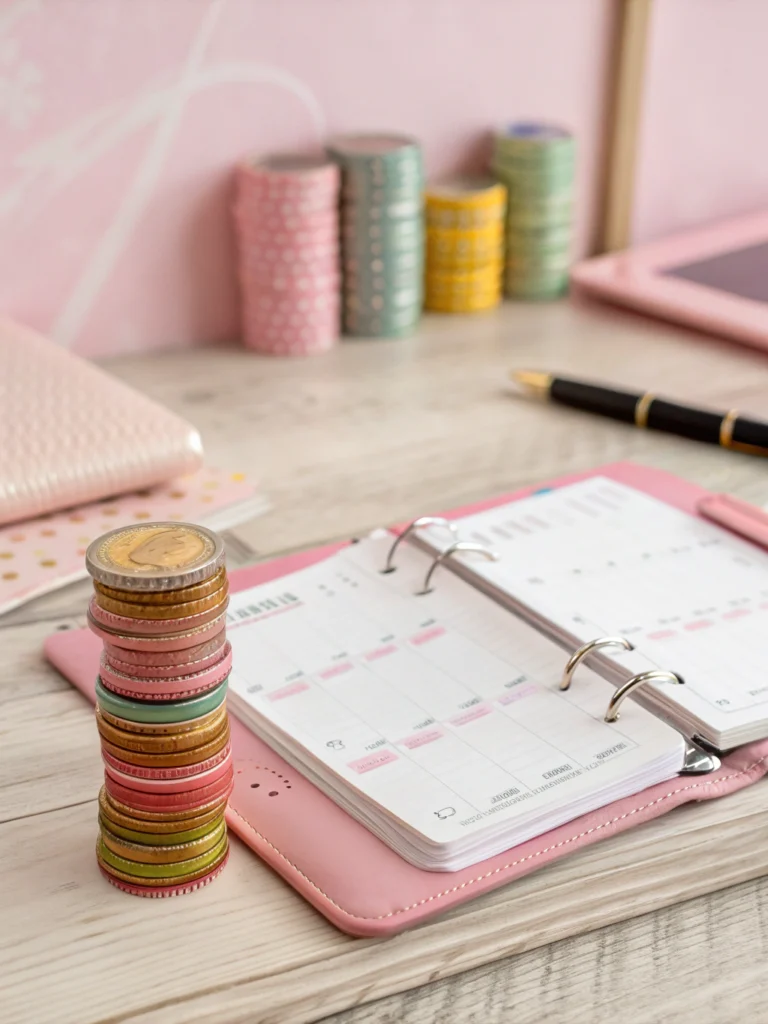Ever feel like your paycheck disappears faster than leftover pizza at a party? You’re not alone. Living frugally isn’t about becoming a penny-pinching hermit who eats instant noodles every night (though no judgment if that’s your jam). It’s about making smarter choices with your money so you can actually afford the stuff that matters to you. Whether you’re drowning in debt, trying to build an emergency fund, or just tired of wondering where your cash went, these Frugal Living Tips for Beginners will help you take control without feeling deprived. I’ll show you practical, real-world strategies that actually work, not just boring advice like “skip your daily coffee” (because seriously, some of us need that caffeine to function).
Table of Contents
No time to read the whole post?
Frugal living doesn’t mean being cheap—it means being intentional with your money. Start by tracking your spending to find money leaks, create a realistic budget that includes fun money, cut unnecessary subscriptions, meal plan to slash grocery bills, embrace secondhand shopping, automate your savings, find free entertainment, practice the 30-day rule before big purchases, and focus on building skills that save you money long-term. Small changes add up to big savings, and you don’t have to sacrifice everything you enjoy to build financial security.
Why Frugal Living Actually Makes Sense (Even If You’re Not Broke)
Let’s get real for a second. Frugal living has this weird reputation for being only for people who are struggling financially. But here’s the thing: some of the wealthiest people you know are probably frugal as heck. They didn’t get rich by throwing money at every shiny object that caught their eye.
Frugal living is really just about being intentional with your money. It’s asking yourself “Do I really need this?” before swiping your card. It’s finding ways to get what you want without paying full price. And honestly? It’s kind of empowering once you get the hang of it.
The best part is that simple money-saving strategies don’t require you to overhaul your entire life overnight. You can start small and build momentum as you see your savings grow.
Track Your Spending Before You Do Anything Else
I know, I know. Tracking expenses sounds about as fun as watching paint dry. But hear me out—you can’t fix what you don’t know is broken.
Most people have absolutely no clue where their money actually goes each month. They think they spend maybe $200 on eating out, when in reality it’s closer to $500. Those “just this once” purchases add up faster than you think.
Grab a notebook, download a budgeting app, or create a simple spreadsheet. For one full month, write down every single expense. Yes, even that $2 candy bar at the gas station. This isn’t about judging yourself—it’s about gathering data.
After 30 days, look at your spending patterns. You’ll probably find some surprising money leaks. Maybe you’re spending $80 a month on subscription services you forgot existed. Or perhaps those convenient coffee shop stops are costing you $150 monthly. Once you see the numbers in black and white, you can make informed decisions about what to cut.
Create a Budget That Doesn’t Make You Miserable
Budgets have this terrible reputation because most people create ridiculously restrictive ones that fail within a week. It’s like going on a crash diet—you’re setting yourself up for failure.
Your budget should reflect reality, not some fantasy version of yourself who never wants to go out with friends or buy anything fun. Here’s how to build a budget that actually works:
Start with your fixed expenses—rent, utilities, insurance, minimum debt payments. These are non-negotiables that you can’t wiggle out of. Next, identify your variable necessities like groceries, gas, and basic household supplies. Finally, and this is crucial, include money for fun stuff. Entertainment, hobbies, dining out—whatever keeps you sane.
The 50/30/20 rule is a solid starting point for beginners: 50% of your income goes to needs, 30% to wants, and 20% to savings and debt repayment. Adjust these percentages based on your situation. If you’re in debt up to your eyeballs, maybe flip that to 50/10/40 temporarily.
Kill the Subscription Zombies Eating Your Budget
Pop quiz: How many subscription services are you currently paying for? If you had to think about it for more than five seconds, you probably have subscription zombies—services that automatically charge you each month even though you barely use them.
Check your bank statements from the last three months and highlight every recurring charge. That gym membership you haven’t used since January? Gone. The streaming service you only watch once a month? Sayonara. The premium app subscription that duplicates features you already have? Deleted.
Keep only the subscriptions that you actively use and genuinely value. You can always resubscribe later if you really miss something. Most people find they can cut $50-150 monthly just by eliminating subscription zombies. That’s $600-1,800 a year!
Master Meal Planning and Watch Your Grocery Bill Plummet
Food is one of the biggest budget categories for most people, and it’s also one of the easiest places to save significant money without much sacrifice.
The secret? Meal planning. I know it sounds boring, but trust me on this one. When you plan your meals for the week, you shop with a list, which means you’re way less likely to impulse-buy that artisanal cheese or fancy snacks you don’t need.
Here’s a super simple system: Set aside 30 minutes on Sunday to plan out your dinners for the week. Check what you already have in your pantry and fridge first. Build meals around those ingredients, then make a specific shopping list for what you’re missing. Stick to that list like your financial life depends on it (because kind of does).
Bonus points for batch cooking. Make a huge pot of chili, soup, or casserole and portion it out for multiple meals. Your future self will thank you when you’re too tired to cook and would normally order expensive takeout.
Also, eat before you grocery shop. Shopping while hungry is a rookie mistake that leads to a cart full of junk you didn’t plan for. Been there, done that, got the credit card bill to prove it. :/
Embrace Secondhand Shopping Like a Pro
New doesn’t always mean better, and buying secondhand is one of the smartest frugal moves you can make. The stigma around used items is pretty much gone now, especially with apps and online marketplaces making it super easy.
Thrift stores, consignment shops, Facebook Marketplace, Craigslist, and apps like Poshmark or Mercari are treasure troves for bargain hunters. You can find quality furniture, clothes, books, electronics, and pretty much anything else for a fraction of retail prices.
I’ve furnished entire rooms from Facebook Marketplace for less than the cost of one new couch from a furniture store. The key is being patient and checking regularly. The good deals go fast, but they’re absolutely out there.
For clothes, especially kids’ clothes that they’ll outgrow in approximately five minutes, buying secondhand is a total no-brainer. Same goes for books, kitchen items, and home decor. Save your money for things that genuinely need to be bought new (like mattresses, car seats, or underwear—some things aren’t worth the savings, ya know?).
Automate Your Savings So You Can’t Mess It Up
Let’s be honest: relying on willpower to save money is a recipe for failure. Life happens, unexpected expenses pop up, and suddenly that money you meant to transfer to savings is gone.
Set up automatic transfers from your checking account to a savings account the day after your paycheck hits. Even if you start with just $25 or $50, you’re building the habit. You can’t spend money you never see in your checking account.
Treat your savings like a bill that must be paid. This is the whole “pay yourself first” concept, and it works because it removes the decision-making process. You’re not tempted to skip it or decide you don’t have enough this month.
As you get more comfortable and find extra money through your frugal efforts, gradually increase that automatic transfer amount. You’d be amazed how quickly those small amounts compound into a legit emergency fund.
Find Free and Cheap Entertainment (It’s Easier Than You Think)
One of the biggest myths about frugal living is that you have to become a boring hermit with no social life. Completely false! You just need to get creative about entertainment.
Libraries are criminally underrated. Most offer way more than just books—think free movies, audiobooks, digital magazines, museum passes, and even community events. Check out local parks for free concerts, festivals, and outdoor activities.
Game nights at home, potluck dinners with friends, hiking, picnics, free museum days, community theater, volunteer work—all of these cost little to nothing and are often more memorable than expensive nights out.
I’m not saying never spend money on fun stuff. But when you consciously choose free or cheap activities most of the time, you can splurge on the experiences that really matter to you without guilt or financial stress.
The 30-Day Rule Will Save Your Budget
Impulse purchases are budget killers. We’ve all been there—you see something online or in a store, and suddenly you NEED it right that second. Then it sits unused in your closet for the next six months.
The 30-day rule is simple: When you want to buy something that’s not an immediate necessity, wait 30 days. Add it to a wishlist and mark the date. If you still want it after 30 days and it fits in your budget, go ahead and buy it.
You’ll be shocked how many things you completely forget about. That “must-have” item often loses its appeal when you give yourself time to think rationally about whether you actually need it or just want it in the moment.
This rule has saved me hundreds (probably thousands) of dollars over the years. It creates space between the impulse and the purchase, giving your logical brain time to catch up with your emotional brain.
Build Skills That Save You Money Long-Term
One of the best investments you can make is in skills that reduce your dependence on paying other people to do things for you. I’m not saying you need to become a master plumber or electrician, but learning basic skills pays off big time.
Cooking from scratch, basic home repairs, simple car maintenance, sewing buttons, basic gardening, DIY cleaning products—these skills might seem small, but they add up to serious savings over time.
YouTube is literally free education for pretty much any skill you want to learn. Spent a weekend learning how to fix a leaky faucet instead of calling a plumber? You just saved yourself $150. Learned to hem your own pants? There’s another $15 saved every time you need alterations.
Plus, there’s something genuinely satisfying about fixing or making something yourself. It builds confidence and self-reliance, which are worth way more than money alone.
Conclusion: Frugal Living Tips for Beginners
Living frugally as a beginner doesn’t have to be complicated or miserable. Start with one or two frugal living tips from this list, get comfortable with them, then add more as you go. Track your spending, create a realistic budget, cut the subscription waste, meal plan like a boss, shop secondhand, automate your savings, find free fun, practice the 30-day rule, and learn money-saving skills.
The goal isn’t perfection—it’s progress. Some months you’ll nail it, other months you’ll slip up. That’s totally normal and okay. What matters is that you’re being more intentional with your money than you were before.
Give these frugal living tips a shot for a few months and watch what happens. You’ll probably be surprised at how much you can save without feeling like you’re sacrificing everything you enjoy. And that emergency fund you’ve been meaning to start? It’ll actually start growing. 🙂
So what are you waiting for? Pick one frugal living tip from this list and implement it this week. Your future financially-secure self will definitely thank you!






